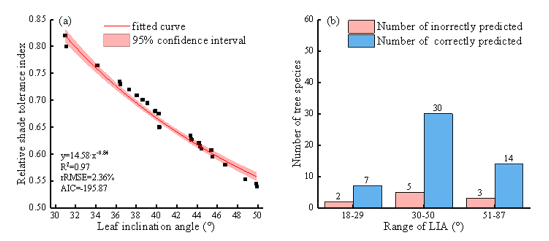Scientists Develop New Quantitative Model to Measure Tree Shade Tolerance
A research team led by Academician ZHU Jiaojun from the Institute of Applied Ecology (IAE), Chinese Academy of Sciences (CAS), has introduced a new quantitative method to classify shade tolerance in trees, offering a valuable tool in forest ecology research and management.
Shade tolerance refers to a tree's ability to survive, grow, and complete its reproductive cycle under chronically low light conditions. It is a critical indicator in studying forest community dynamics. It plays a key role in understanding species composition, forest structure, ecological succession, and the selection of tree species for afforestation. Traditionally, shade tolerance has been divided qualitatively into broad categories such as shade-intolerant, shade-tolerant, and intermediate, but such classifications lack universal quantitative standards. This limitation has hindered research on light adaptation strategies and posed challenges for precision in forest management.
The CAS team addressed this gap by applying terrestrial laser scanning (TLS), a high-resolution ground-based remote sensing technique, to measure leaf inclination angle (LIA) as a central parameter for evaluating shade tolerance. They further developed a “Relative Shade Tolerance Index” (RSTI) model, providing a new tool to quantify light adaptation strategies in temperate forest species.
The study was carried out at two national field research stations (the Qingyuan Forest Ecosystem Research Station in Liaoning Province and the Changbai Mountain Forest Ecosystem Research Station in Jilin Province). Using TLS, researchers performed multi-angle, high-precision 3D scans on 23 species of broadleaved trees, with each tree scanned from five to six points across different canopy heights. By applying a curvature-adaptive algorithm to extract leaf surface orientation, the team achieved highly accurate LIA measurements.
Cluster analysis based on average LIA values, vertical distribution, and frequency characteristics divided the 23 tree species into five categories: very shade-intolerant, shade-intolerant, moderately shade-tolerant, shade-tolerant, and very shade-tolerant.
This led the researchers to propose the Relative Shade Tolerance Index. The RSTI treats shade tolerance as a continuous function, expressed through a nonlinear predictive model. The index is scaled between 0 and 1: when LIA equals 18°, RSTI equals 1, representing extreme shade tolerance; when LIA equals 90°, RSTI equals 0, indicating extreme shade intolerance. Validation with published data on 61 temperate broadleaved tree species showed the model achieved an overall prediction accuracy of 83.6%, with particularly robust performance in the LIA range of 51° to 87° (Figure 1).
According to the authors, the study not only introduces an operational method for the quantitative classification of shade tolerance but also demonstrates the advantages of TLS scanning in improving the completeness and precision of canopy structural data. The findings provide forestry practitioners with a measurable index. Simply by calculating the RSTI value between 0 and 1, one can determine the degree of shade tolerance of a tree species with improved accuracy.
The research, titled “Leaf inclination angle of broadleaved tree species and its application on estimating tree shade tolerance in temperate forests, Northeast China,” was published in the journal Forest Ecology and Management.

Figure 1. shows the Relative Shade Tolerance Index model: (a) the relationship between RSTI and leaf inclination angle; (b) model validation results (Image by CHEN Qingda).



